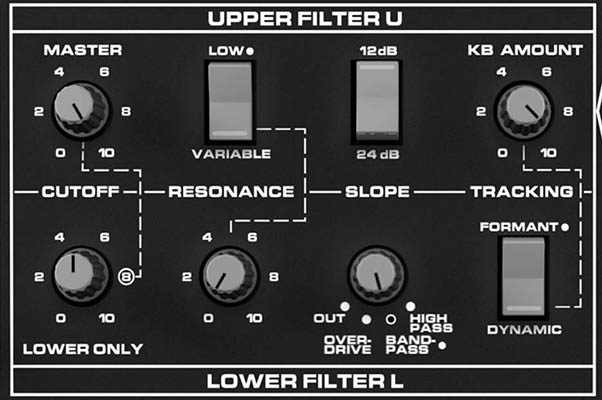Filters
At the heart of any great synth is a great filter. It's the part that gives a sound its shape and its soul. Like a singer’s voice, a good filter can shape tone into something unique and powerful. The Spirit doesn’t just have one filter. It has two: Filter U and Filter L. And no, the “U” and “L” don’t stand for “upper” and “lower” frequencies. They’re just geographically named. One’s up top. One’s down low. That’s it. But don’t let the naming fool you: these two filters come from entirely different sides of the sonic gene pool. They’re not just powerful, they’re full of quirks and surprises.
Filter U is a classic low-pass with familiar trimmings: cutoff, resonance, keyboard tracking, and its own ADSR with adjustable depth and polarity. You can even flip between 12 dB and 24 dB slopes if you’re in the mood to swap your synth ancestry (think SEM vs. Moog). And yes, there’s resonance, with a switch that sets it to either a fixed “Low” amount or "Variable" to let you dial it in manually.
Filter L, on the other hand, is the wildcard. It has four modes, starting with “Out” (aka, skip me), and ramping up from there. “Overdrive” drops a gritty distortion stage in the path and transforms Filter L into a parametric EQ, which is useful for hyping the mids without shaving off the highs or lows. “Band-pass” works similarly, minus the grit. And “High-pass” does exactly what it says, which means that Spirit is fully capable of true dual-filter voicing, one carving from the top, the other from below.
A Dynamic/Formant switch flips how Filter L behaves. In Dynamic mode, it’s fully modulatable: envelopes, tracking, LFOs, the works. But switch it to Formant mode, and modulation shuts off entirely. Filter L becomes static, a fixed resonant shape layered under the movement of Filter U. It’s a great trick for adding vocal-like color, or just giving your sounds a center that doesn’t shift with the rest.
One more twist: Filter L doesn’t use an absolute cutoff value. Instead, it’s relative to Filter U. When the cutoff knob is near 8 o’clock, the two filters align. Turn it clockwise or counterclockwise, and Filter L drifts above or below Filter U’s frequency. Depending on the mode, you can either make them work in unison, or push them apart for harmonics that speak with personality.
It’s a flexible, slightly eccentric system. And if you lean into the quirks, Spirit rewards you with textures most synths can't duplicate.
Upper Filter (U)
This is the classic analog low-pass filter. It’s responsible for the familiar “synth sweep” and can get mellow, aggressive, or anything in between.
CUTOFF
Sets the master cutoff frequency for the entire filter path. If LOWER ONLY is set to 8, both filters track this setting identically. Range: full audio spectrum.RESONANCE
Adds emphasis at the cutoff frequency. Switchable between:LOW * (Q ≈ 0.5): Fixed low resonance for sonic weight and subtle shaping.
VARIABLE: Lets the RESONANCE knob control Q from mild to self-oscillating.
SLOPE
Selects the filter slope:12 dB/oct: Gentler slope, more SEM-style.
24 dB/oct: Steeper slope, more Moog-style.
TRACKING (KB AMOUNT)
Controls how much the cutoff follows keyboard pitch. Set it to 10 for near-perfect tracking (1V/oct), or dial it down for less tracking across the keyboard.
Lower Filter (L)
This is where things get interesting. The Lower Filter isn’t just a second low-pass. It’s a chameleon. Depending on the mode, it can act as a parametric EQ, a high-pass filter, or even disappear completely.
OUT
Bypasses the Lower Filter entirely. What you hear is just the Upper Filter.OVERDRIVE
Adds a gritty distortion between the two filters and transforms the Lower Filter into a parametric boost. Great for midrange growl and character.BAND-PASS *
Like Overdrive, but without the fuzz. Still gives a focused, double-peaked response centered around the cutoff.HIGH-PASS
Attenuates frequencies below the cutoff. Used with the Upper Filter, this creates a dual-filter high/low-pass architecture. This is useful for adding sizzle and attenuating the low end.
Cutoff Controls:
LOWER ONLY (CUTOFF OFFSET)
Moves the Lower Filter’s cutoff relative to the Upper Filter. At 8, both filters are aligned. Below 8, the Lower Filter sits beneath. This lets you:Stack the filters for twin peaks
Carve a formant under the main filter
Create motion between filters using different tracking or envelopes (via Matrix Z)
Tracking Mode Switch:
FORMANT *
Freezes the Lower Filter’s cutoff. It no longer responds to keyboard tracking, envelopes, or modulation. This is useful for creating fixed peaks or formant-like resonances that stay put as you play.DYNAMIC
Reconnects the Lower Filter to keyboard tracking, filter envelope, and modulation.
RESONANCE
Always adjustable via the RESONANCE knob, regardless of mode. Controls the intensity of the filter peak.
Filter Interplay
Because these filters are tied together, but also independently controllable, you can sculpt complex timbres. For example:
Stack both filters with a narrow offset for rich, vocal peaks.
Freeze the Lower Filter (by enabling Formant) while modulating the Upper Filter, to create evolving textures over a static tonal center.
Combine high-pass and low-pass modes for a band-reject or twin-peak effect.
Use Overdrive to inject harmonic grit into an otherwise clean sound.
Combine Low resonance, band-pass, and Formant tracking to better emulate brass and woodwind timbres.
* NOTE: Three selections are marked with a dot to indicate their relationship in designing Formant sounds. These selections include the Low setting for the RESONANCE switch in the Upper Filter, the Band-Pass FILTER setting, and the Formant setting of the TRACKING MODE switch. When these settings are activated, you can adjust the Upper Filter using the Filter Envelope, modulations, and other controls without altering the resonant formant produced by the Lower Filter.
